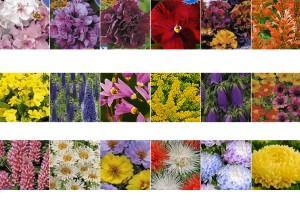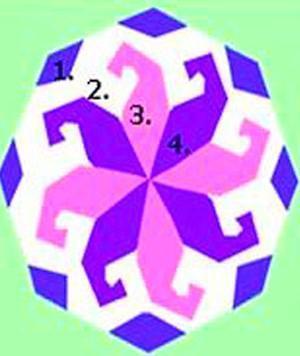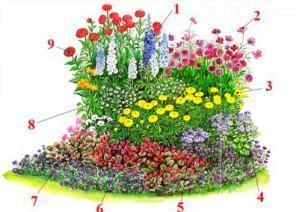A flower bed of annuals - cozy and beautiful
 Flowers on the garden plot create a great mood. Bright multi-colored annual flower beds are pleasing to the eye all season. Many growers have repeatedly faced the problem of creating beautiful flower beds. Consider the main parameters required to achieve amazing elegance of flower arrangements.
Flowers on the garden plot create a great mood. Bright multi-colored annual flower beds are pleasing to the eye all season. Many growers have repeatedly faced the problem of creating beautiful flower beds. Consider the main parameters required to achieve amazing elegance of flower arrangements.
Selection of annual flowers for a flower bed
The stores offer a wide range of flowers. Annual flower bed flowers (photo) are quite diverse.
The first step is to deal with the most common types of annual plants suitable for creating flower beds. The height of the plant and the period of its flowering are indicated in brackets. So:
- Ageratum (15 cm - 70 cm, early June - first frosts);
- Marigolds (15 cm - 100 cm, June - September);
- Gatsania (25 cm - 35 cm, mid June - September);
- Iberis (up to 40 cm, from early June to frost);
- Clarkia (25 cm - 45 cm, early July - September);
- Lobelia (there are two types: ampelous and bush. Both species bloom in early June and stand until October. The height of the bush plant is 15 cm);
- Nasturtium (creeping reaches up to 4 m in size, and bush grows up to 50 cm. Flowering continues from the beginning of heat until severe frosts);
- Petunia (bush 15 cm - 80 cm. Ampel petunia grows more than 1 m. Both species bloom from the beginning of the warm season to mid-October);
- Tobacco (80 cm, pleases with flowering from June to early October);
- Zinnia (depending on the variety 20 - 70 cm, from the beginning of June to the first frost);
- Escholzia (another name for the plant is the California poppy. Height varies from 20 cm to 60 cm. It blooms from June until the first frost).
All annual plants can be divided into tall and low-growing plants, the height of which is no more than 25 cm. One-year low-growing flowers for flower beds include, for example:
- Some varieties of Ageratum;
- Dwarf begonia;
- Dwarf aster;
- Viola;
- Lobelia bush;
- Lobularia and others.
Principles of creating a flower bed from annuals
Before you start arranging a flower garden, you need to choose a suitable place (most annual plants are very fond of sunlight), think over the shape of the flower bed (the most common flower beds are in the form of geometric shapes), choose annual flower beds that match the color scheme, plan the placement of plants.
Do not forget about the simple rules for creating different flower beds:
- Tall plants should be placed in the background or in the center of the flower bed.
- As you approach the edges of the flower garden, the height of the plants should decrease commensurately. It is not recommended to allow strong variations in the size of colors.
- In the foreground, a small border of low-growing flowers will look more beautiful and neat.
- The planting density of plants in the flowerbed increases with decreasing plant height.
Consider some traditional patterns of annual flower beds

To obtain a flower bed of a bluish-purple hue, plants of the corresponding colors are needed:
- Lobelia
- Alissum
- Petunia
- Ageratum
The size of plants from the center of the flower bed - 25 cm decreases to the edges - 10 cm. Such a composition will bloom and amaze with its beauty from the warmest days to mid-September.
Scheme 2
 A colorful and bright flower bed can attract the attention of a variety of butterflies. Used in the flower garden:
A colorful and bright flower bed can attract the attention of a variety of butterflies. Used in the flower garden:
- Delphinium
- Kosmeya
- Marigold
- Ageratum
- Begonia
- Verbena
- Petunia
- Tobacco
- Dahlias
Scheme 3
 This pattern of annual beds is suitable for round flower beds. The composition consists of:
This pattern of annual beds is suitable for round flower beds. The composition consists of:
- Alissum
- Ageratum
- Petunia
- Marigold
The color scheme of plants should completely match the colors in the diagram. The height of the flower bed in the center is 55 - 60 cm, and at the very edge - 15 cm.
Caring for annual flower beds
 It takes a lot of time to create a flower bed correctly and beautifully, but taking care of flower arrangements is quite simple. Naturally, all flowers love moisture. For annual plants, moderate watering is required, since most of them do not tolerate stagnant liquid. If the summer is rainy, then watering annual beds is not recommended, and if the weather is dry, then watering should be regular (approximately 1 watering every 3-4 days). It is better to do this after sunset so that moisture droplets do not damage the plantings.
It takes a lot of time to create a flower bed correctly and beautifully, but taking care of flower arrangements is quite simple. Naturally, all flowers love moisture. For annual plants, moderate watering is required, since most of them do not tolerate stagnant liquid. If the summer is rainy, then watering annual beds is not recommended, and if the weather is dry, then watering should be regular (approximately 1 watering every 3-4 days). It is better to do this after sunset so that moisture droplets do not damage the plantings.
For long-term flowering, plants should receive regular (every 2.5 - 3.5 weeks) feeding. The type of fertilizer is selected depending on the structure of the soil under the flower garden.
You can use both mineral and organic fertilizers. If the structure of the soil cover is not known, then it is advisable to use complex, universal fertilizers, examples of which are shown in the figure.
Some types of annuals (eg, lobelia, phlox) require regular loosening of the soil around their root system. This is necessary for their growth and development. All flowers must be weeded out in a timely manner, otherwise the weeds can completely destroy the rhizomes of ornamental plants.
If the selected annual flowers for the flower bed can bloom several times per season, then it is necessary to constantly remove dried inflorescences and other damaged plant areas from the flower garden. This procedure will avoid rotting flowers and various diseases that can destroy plants.
With the modern abundance of choice of annuals, each person, using the recommendations, will easily create unique flower beds on their site. These can be as flower beds of one type of plants (monoclumba), and various alpine slides, vertical flower beds, mixborders, arabesques (flower beds in the form of animal images). And if for flower beds carefully and in a timely manner, they will delight the owners for a long time with abundant flowering and amazing beauty.